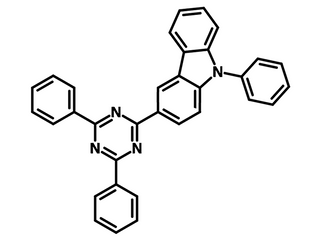DPTPCz
CAS Number 1313391-57-9
High Purity Sublimed Materials, Host Materials, Materials, OLED Materials,DPTPCz, phosphorescent OLED host material
Universal bipolar co-host for blue, green and red LEDs, 3-(4,6-Diphenyl-1,3,5-triazin-2-yl)-9-phenyl-9H-carbazole, CAS No. 1313391-57-9, Sublimed ≥99.0%
DPTPCz is an isomer to Cab-Ph-TRZ with triazine as electron-deficient and carbazole as electron-rich moieties. The difference between them is that for DPTPCz, triazine is directly attached to the carbazole unit while there is a phenyl spacer between the triazine and carbazole units for Cab-Ph-TRZ.
DPTPCz is used as a phosphorescent host material for blue, green and red light-emitting diodes. The bipolar host can achieve balanced charge injection/transport in phosphorescent organic light emitting diodes (PhOLEDs). Nearly 100% triplet harvesting in conventional fluorophor-based organic light-emitting devices is realized through energy transfer from TAPC:DPTPCz exciplex with C545T-doped device. The device showed a maximum current efficiency of 44.0 cd A-1, a maximum power efficiency of 46.1 lm W-1, and a maximum external quantum efficiency of 14.5% [3]
General Information
| CAS number | 1313391-57-9 |
|---|---|
| Full name | 3-(4,6-Diphenyl-1,3,5-triazin-2-yl)-9-phenyl-9H-carbazole |
| Chemical formula | C33H22N4 |
| Molecular weight | 474.55 g/mol |
| Absorption | λmax 305, 353 nm in Ethyl acetate |
| Fluorescence | λmax 416 nm in Ethyl acetate |
| HOMO/LUMO | HOMO 5.69 eV, LUMO 2.76 eV, ET = 2.78 eV[1] |
| Synonyms | DPTPCz |
| Classification / Family | Triazine derivatives, Bipolar host materials, PHOLEDs host materials, Sublimed materials. |
Product Details
| Purity | Sublimed >99.0% (HPLC) |
|---|---|
| Melting point | Tg = 86 ℃ |
| Appearance | White powder/crystals |
*Sublimation is a technique used to obtain ultra pure-grade chemicals. For more details about sublimation, please refer to the Sublimed Materials.
Chemical Structure

Device Structure(s)
| Device structure | ITO/NPB (30 nm)/TCTA (10 nm)/DPTPCz:Ir(ppy)2acac (7 wt%, 30 nm)/TPBi (30 nm)/LiF (1 nm)/Al [1] |
|---|---|
| Color | Green |
| Max. EQE | 21.2% |
| Max. Current Efficiency | 65.7 cd/A |
| Device structure | ITO/NPB (30 nm)/TCTA (10 nm)/DPTPCz:FIrPic (12 wt%, 30 nm)/TAZ (30 nm)/LiF (1 nm)/Al [1] |
|---|---|
| Color | Blue |
| Max. EQE | 14.4% |
| Max. Current Efficiency | 27.4 cd/A |
| Device structure | ITO/NPB (30 nm)/TCTA (10 nm)/DPTPCz:Ir(2-phq)3(6%; 30 nm)/TPBi (30 nm)/LiF (1 nm)/Al (100 nm) [2] |
|---|---|
| Color | Red |
| Max. Luminance | 22,480 cd/m2 |
| Max. Current Efficiency | 31.66 cd/A |
*For chemical structure information, please refer to the cited references.
Pricing
| Grade | Order Code | Quantity | Price |
|---|---|---|---|
| Sublimed (>99.0% purity) | M2313A1 | 250 mg | £330 |
| Sublimed (>99.0% purity) | M2313A1 | 500 mg | £520 |
| Sublimed (>99.0% purity) | M2313A1 | 1 g | £850 |
MSDS Documentation
Literature and Reviews
- Novel bipolar host materials based on 1,3,5-triazine derivatives for highly efficient phosphorescent OLEDs with extremely low efficiency roll-off, X. Liu et al., Phys. Chem. Chem. Phys., 14, 14255-14261 (2012); DOI: 10.1039/C2CP41542A.
- Highly efficient green and red phosphorescent OLEDs using novel bipolar blue fluorescent materials as hosts, J. Xiao et al., Synth. Met., 193, 89-93 (2014); DOI: 10.1016/j.synthmet.2014.04.001.
- Nearly 100% Triplet Harvesting in Conventional Fluorescent Dopant-Based Organic Light-Emitting Devices Through Energy Transfer from Exciplex, X. Liu et al., Adv. Mater., 27 (12); 2025-2030 (2015); DOI: 10.1002/adma.201500013.
